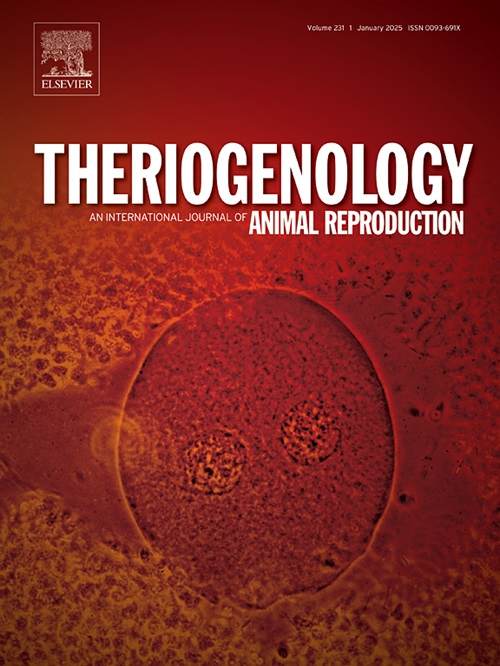High out-of-season fertility in progesterone-treated goats joined with sexually active bucks and artificially inseminated with fresh diluted semen
IF 2.4
2区 农林科学
Q3 REPRODUCTIVE BIOLOGY
引用次数: 0
Abstract
In seasonal anestrous goats, artificial insemination (AI) is typically preceded by hormonal treatment. This study examined whether high fertility can be achieved after AI with fresh diluted semen in progesterone (P4)-treated goats exposed to sexually active (SA) bucks. In Experiment 1, two groups of goats (n = 30 each) were joined with SA bucks (n = 2 per group) fitted with abdominal aprons. Prior to teasing, the P4-group received an intramuscular injection of 25 mg of progesterone diluted in 2 mL of olive oil, while the control group received olive oil alone. AI was performed 12 h after estrus onset within five days after buck introduction, using semen packed in 0.2 mL straws containing 80 × 10⁶ spermatozoa. The kidding rate was higher in the P4-treated group (24/30, 80 %) compared to the control group (8/30, 27 %; P < 0.001). In Experiment 2, two groups (n = 30 each) were exposed to SA bucks (n = 2 per group). The control group was inseminated 12 h after estrus onset detected between six- and nine-days post-introduction, while the P4-group was inseminated within five days. Kidding rates were similar between the P4-group (26/30, 86 %) and the control group (23/30, 77 %; P > 0.05). These results indicate that P4-treated goats achieve high fertility when inseminated during the first estrus induced by males, while control goats achieve high fertility when inseminated during the second estrus.
求助全文
约1分钟内获得全文
求助全文
来源期刊

Theriogenology
农林科学-生殖生物学
CiteScore
5.50
自引率
14.30%
发文量
387
审稿时长
72 days
期刊介绍:
Theriogenology provides an international forum for researchers, clinicians, and industry professionals in animal reproductive biology. This acclaimed journal publishes articles on a wide range of topics in reproductive and developmental biology, of domestic mammal, avian, and aquatic species as well as wild species which are the object of veterinary care in research or conservation programs.
 求助内容:
求助内容: 应助结果提醒方式:
应助结果提醒方式:


